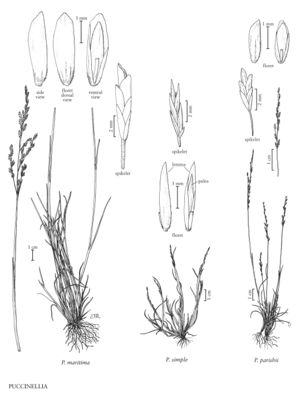Puccinellia maritima
Plants perennial; cespitose, often stoloniferous, not mat-forming. Culms 20-100 cm, erect to decumbent. Ligules 1-3.5 mm, obtuse to truncate, entire; blades 2-4.4 mm wide, flat to involute. Panicles 3-30 cm, compact to diffuse at maturity, lower branches erect to descending, spikelet-bearing from about midlength; pedicels usually densely scabrous, occasionally with only a few scattered scabrules, often with tumid epidermal-cells. Spikelets 5.5-13 mm, with 4-9 florets. Glumes rounded over the back, veins obscure, apices acute to obtuse; lower glumes 2-3.4 mm; upper glumes 3-4.5 mm; calluses with few-to-many hairs; lemmas 3-5 mm, slightly to markedly coriaceous throughout, sparsely to densely hairy in the lower 1/2, principally along the veins, backs rounded, 5-veined, veins obscure, usually not extending to the margins, sometimes the midvein doing so, apical margins usually smooth, sometimes with a few scattered scabrules, occasionally densely scabrous, apices acute to obtuse, entire; palea veins ciliate proximally, scabrous to short-ciliate distally; anthers 1.5-2.6 mm. 2n = 14-77, usually 56.
Distribution
Maine, N.H., N.J., Greenland, N.B., N.S., P.E.I., Que., Mass., Wash., N.Y., Calif., Del., Conn., Pa., R.I.
Discussion
Puccinellia maritima grows in coastal environments in North America and Greenland. It is native to Europe; most or all occurrences in the Flora region are probably the result of human introduction.
Selected References
None.
Lower Taxa
"decumbent" is not a number.
